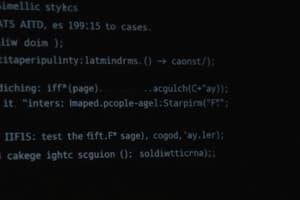Podcast
Questions and Answers
In the provided script, what would be the output if the user enters '29' for 'marks'?
In the provided script, what would be the output if the user enters '29' for 'marks'?
- Congratulations You cleared the subject
- Congratulations You Failed
- You cleared the subject Congratulations
- You Failed Better Luck Next Time (correct)
What is the purpose of the 'elif' statement in Python?
What is the purpose of the 'elif' statement in Python?
- To execute a block of code only if the previous 'if' condition is False. (correct)
- To define a function that can be called later in the program.
- To execute a block of code only if the previous 'if' and 'elif' conditions are False.
- To create a loop that will continue running until a certain condition is met.
For 'marks = 50', which of the following statements are TRUE based on the provided script?
For 'marks = 50', which of the following statements are TRUE based on the provided script?
- marks >= 50 (correct)
- marks < 50
- marks > 50
- marks == 50 (correct)
Which line of code will be executed if the user enters '40' for 'marks'?
Which line of code will be executed if the user enters '40' for 'marks'?
What is the correct way to convert a string input to an integer in Python?
What is the correct way to convert a string input to an integer in Python?
Which of the following embodies the correct structure of an if statement in Python?
Which of the following embodies the correct structure of an if statement in Python?
What happens if the condition in an if statement evaluates to FALSE?
What happens if the condition in an if statement evaluates to FALSE?
How many else statements can be combined with a single if statement?
How many else statements can be combined with a single if statement?
Which of the following functions correctly checks if a variable x is equal to 5?
Which of the following functions correctly checks if a variable x is equal to 5?
What is the role of indentation in Python's if statements?
What is the role of indentation in Python's if statements?
How would the output of the following code be?
x=5
if x>10:
print('x is greater than 10')
How would the output of the following code be?
x=5 if x>10: print('x is greater than 10')
What should you do to display that a user has entered a positive integer if the integer is greater than or equal to 2?
What should you do to display that a user has entered a positive integer if the integer is greater than or equal to 2?
Flashcards
if-else statement
if-else statement
A conditional statement that executes code based on whether a condition is true or false.
True statements
True statements
Statements executed when the if condition evaluates to true.
elif statement
elif statement
A conditional branch that allows checking multiple expressions for truth.
else statement
else statement
Signup and view all the flashcards
conditional flow
conditional flow
Signup and view all the flashcards
Conditional Statements
Conditional Statements
Signup and view all the flashcards
Structure of if Statement
Structure of if Statement
Signup and view all the flashcards
Logical Expression
Logical Expression
Signup and view all the flashcards
Example of if Statement
Example of if Statement
Signup and view all the flashcards
Optional Else Statement
Optional Else Statement
Signup and view all the flashcards
Indentation in Python
Indentation in Python
Signup and view all the flashcards
Study Notes
Introduction to Python - Conditional Statements
- Conditional statements in Python allow the program to make decisions based on conditions.
- The primary conditional statement in Python is
if. ifstatements evaluate a logical expression and, if true, execute a block of code indented under theifstatement.- Python's indentation rules define code blocks. Statements indented the same amount belong to the same block.
Conditional - if Statement
- Python's
ifstatements are similar to other programming languages. - The statement needs a logical expression.
- A decision is made based on whether the expression is true or false.
Conditional - if Structure
- The
ifstatement in Python Programming has a simple structure:if expression: statement(s) - The statement(s) after the colon are executed only if the expression evaluates to True.
- The expression must be a condition, like a comparison or a logical check.
- All statements indented by the same number of spaces after a programming construct (in this case, the if statement) are considered to be part of a single code block.
Conditional - if Example
x = 5if x == 5:print(x, 'is equal to 5')if x > 10:print (x, 'is greater than 10')
Conditional - if (Indentation Concept)
- Indentation is crucial in Python to define code blocks.
- The block of code directly under an 'if statement' is solely dependent upon the if expression being true.
- Incorrect indentation leads to errors.
Exercise 1
- Write a Python program that prompts the user for an integer.
- If the integer is greater than or equal to 2, display that the integer is positive.
Conditional - if-else Statement
- An
elsestatement can be combined with anifstatement. - An
elsestatement contains the code that executes if theifstatement's condition is false. - The
elsestatement (if used) must be indented at the same level as theifstatement - An
if-elsestatement has at most oneelsestatement.
Conditional - if-else Statements
-
if(Test condition): If the condition evaluates toTrue, the corresponding code block will execute. -
else: If the condition isFalse, theelseblock will execute.
Conditional - if-elif-else Statements
- An
elifstatement allows multiple conditions to be evaluated. elifcan be used multiple times afterif.- The
if-elif-elsestructure continues to test conditions until it finds one that evaluates toTrue. - Python only executes the code block for the first condition that evaluates as
True. - Once a
Truecondition is found the rest of theelifandelseconditions are bypassed.
if-elif-else Syntax
if (condition 1):
statements 1
elif (condition 2):
statements 2
elif (condition 3):
statements 3
.
.
elif (condition n):
statements n
else:
default statements
Exercise 2
- Provide the output for a given integer input value, based on a sample
if/elsescript. - Determine the true statement(s) when a specific value is given.
- State which line of the given code will execute with a specific integer input.
Exercise 3
- A Python script uses
if,elif, andelseto determine different discount rates based on age. - Determine the different outputs when specific ages are inputted.
Studying That Suits You
Use AI to generate personalized quizzes and flashcards to suit your learning preferences.




